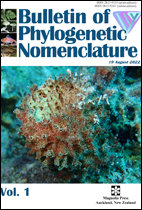Abstract
When authors have proposed phylogenetically defined names that satisfy the requirements for publication but not those for establishment, the protologues must either be corrected with published errata or republished in a way that satisfies the requirements. The current version of the PhyloCode does not indicate whether the authorship and date of the names are those of the original publication in which the names were proposed or those of the subsequently published errata or full protologues in which all the requirements for establishment were satisfied. We propose modifications to the PhyloCode such that for converted clade names (Art. 6.3), the nominal author(s) (Art. 19.1) and date are those of the original publication in which the name was proposed (not the one in which it was first defined phylogenetically), but the definitional author(s) (Art. 19.1) and date are those of the subsequent publication in which all the requirements for establishment are satisfied. For new clade names (Art. 9.1), we propose that both the nominal author(s) and date and the definitional author(s) and date are those of the subsequent publication in which all the requirements for establishment are satisfied. An exception is proposed for new clade names that are simultaneously established under a rank-based code.
References
- Cantino, P. D., and K. de Queiroz. 2020. International Code of Phylogenetic Nomenclature (PhyloCode). CRC Press, Boca Raton, Florida. https://doi.org/10.1201/9780429446320
- Johnson, M. M., M. T. Young, and S. L. Brusatte. 2020. The phylogenetics of Teleosauroidea (Crocodylomorpha, Thalattosuchia) and implications for their ecology and evolution. PeerJ 8:e9808. https://doi.org/10.7717/peerj.9808
- Johnson, M. M., M. T. Young, A. Brignon, and S. L. Brusatte. 2022. Addition to “The phylogenetics of Teleosauroidea (Crocodylomorpha, Thalattosuchia) and implications for their ecology and evolution.” Bulletin of Phylogenetic Nomenclature 001 (1):001–007. https://doi.org/10.11646/bpn.1.1.1


